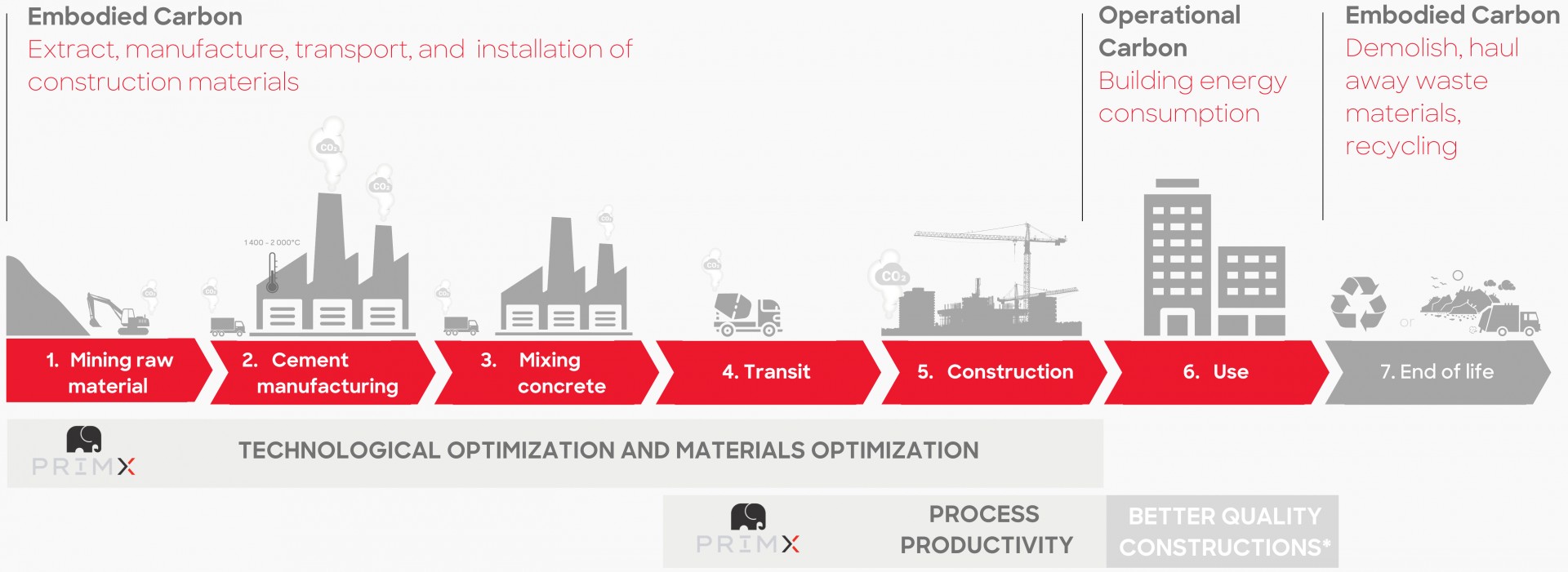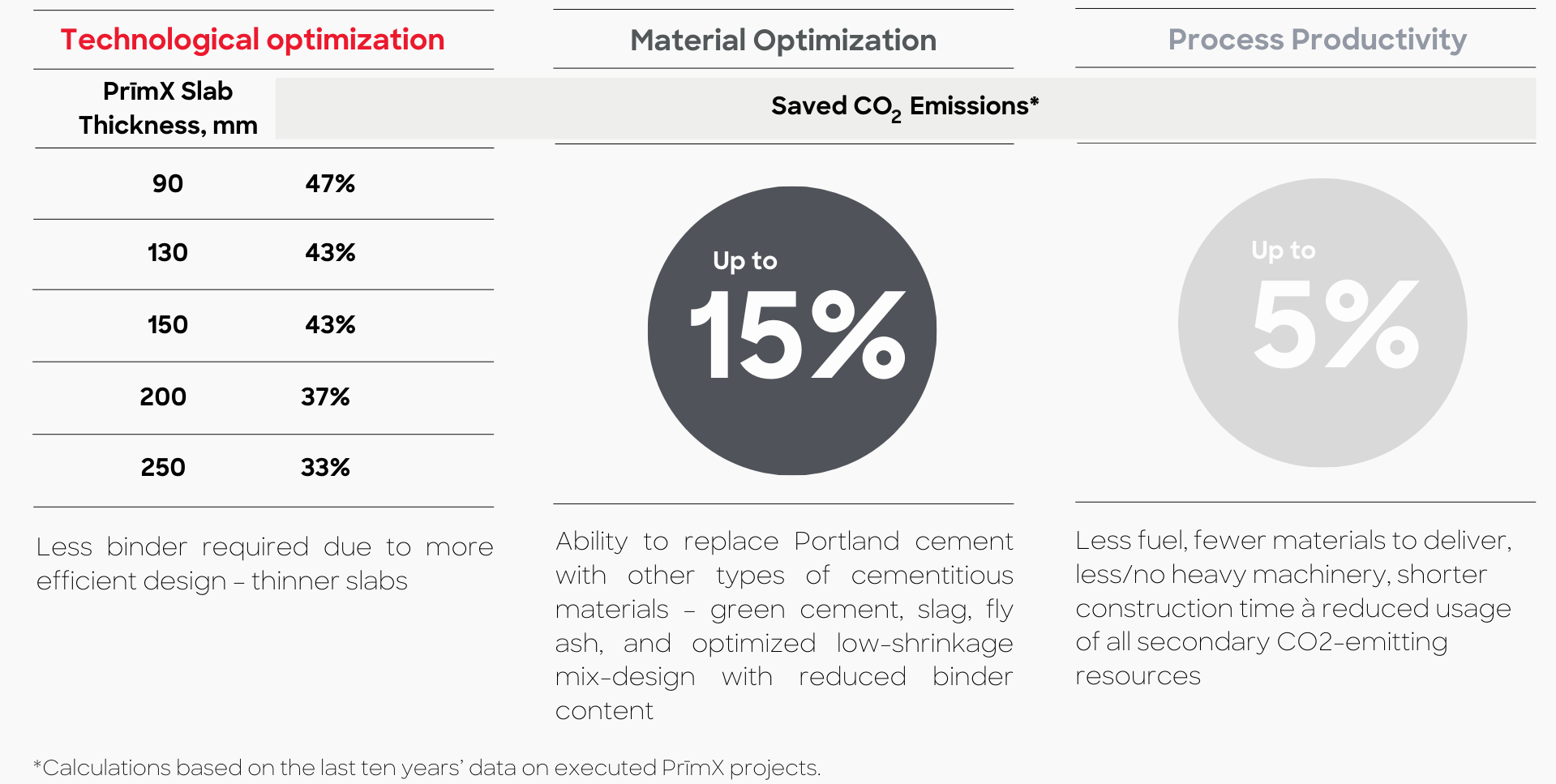We contribute to a more sustainable world through innovative, high-quality concrete technology designed responsibly and poured with the highest quality.
With concrete responsible for about 8% of carbon dioxide emissions worldwide, PrīmX is well-placed to make a meaningful impact on the global stage. PrīmX - jointless, self-stressing, steel-fiber reinforced composite concrete is much stronger than traditional concrete. Thus, combining smart material choices and optimized production processes makes it possible to design structures that use less concrete and save up to 70% of CO2 emissions.
PrīmX in the concrete CO2 emission life cycle
PrīmX concrete production starts with a project-specific binder (cement and supplementary cementitious materials) plus a selection of other concrete-related materials. It is followed by test-assisted optimization ensured by Primekss Labs. As soon as the mix design is specified and the trial mix is lab tested and approved, PrīmX concrete production takes place partly in a concrete batching plant and partly on-site. During the latter on-site stage, various additives and steel fiber reinforcement are integrated into the project-specified ready-mix concrete.
Therefore, mixing concrete (step 3 in the image below) is the first instance of PrīmX directly impacting the amount of CO2 emitted. However, in the case of PrīmX technology, a major reason for lower CO2 emissions is the use of less concrete and thus less cement, which in turn has an indirect impact on previous steps: fewer raw materials extracted and less cement manufactured.
 *- PrīmX technology eliminates the negative effects of concrete drying shrinkage, preventing curling and thereby allowing the construction of jointless, lifetime flat floors that, in turn, require minimal maintenance and reduce CO2 emissions.
*- PrīmX technology eliminates the negative effects of concrete drying shrinkage, preventing curling and thereby allowing the construction of jointless, lifetime flat floors that, in turn, require minimal maintenance and reduce CO2 emissions.
Three pillars of PrīmX CO2 emission saving
1. Technological optimization - Optimized design, thinner cross section
PrīmX is engineered to improve material characteristics by eliminating the negative effects of drying shrinkage. Restrained drying shrinkage results in material cracking, curling, and other effects that lessen the effectiveness of concrete as a building material. Traditional concrete compensates for these effects in different ways (i.e., thicker cross sections, extra steel rebar reinforcement, joints, etc.), all of which result in inefficient material application and much higher CO2 emissions due to primary or secondary sources.
With PrīmX, it’s different – the special additives and steel fiber reinforcement make it possible to create chemically self-stressed, dimensionally stable material that can be applied more efficiently. So, cross sections can be designed thinner but still have the same load-bearing capacity. This leads to impressive material and CO2 emission savings.
Benefits from technological optimization:
- Reducing the cross-section makes the PrīmX designs thinner, thus reducing demand for concrete and the slab's carbon footprint, usually by 40% or more;
- At the same thickness, PrīmX Steel Fiber Reinforced Self-Stressing concrete slabs have a much higher load-bearing capacity, making it possible to fully eliminate or drastically reduce the steel mesh reinforcement used in construction – another CO2 emission-intensive material.
- Thinner slabs and the more efficient PrīmX technology construction process reduce consumption of our limited resources and lower CO2 emissions during construction.
2. Materials Optimization - Smart material choices, Portland cement substitution
Project-specific custom concrete design preparation is critical for ensuring the PrīmX system works properly. Therefore, Primekss Labs perform aggregate and binder analysis and tests to develop the optimal PrīmX mix. Our in-depth knowledge of the process allows us to select materials with less CO2 emission potential for our designs. Smart material choices – where possible, substituting Portland cement for other cementitious materials – lead to additional CO2 emission savings.
3. Process efficiency and productivity - A smaller CO2 footprint during delivery, efficient construction, less maintenance
The main driver of process productivity is that significantly less concrete is necessary for production. Emissions of CO2 related to concrete delivery are meaningfully reduced, and further savings are made because the heavy machinery for delivering and unloading heavy steel reinforcement materials is no longer necessary.
Average CO2 savings for different slab thicknesses

See attached materials:
Environmental product declaration (EPD) and scientific literature explaining in more detail how PrīmX technology saves CO2 emissions:
- Environmental Product Declaration In accordance with ISO 14025 and EN 15804:2012+A2:2019 for PrīmX SFRSSC (Steel Fiber Reinforced Self-Stressing Concrete) Slab Systems In different thicknesses (90 – 130 – 150 – 200 – 250 mm)
The life cycle assessment (LCA) worked out by Bureau Veritas Latvia. Email: riga@bureauveritas.com
Third-party verifier: Marcel Gómez Ferrer, Marcel Gómez Consultoria Ambiental.
Email: info@marcelgomez.com
Approved by: The International EPD® System
- Article: Reducing CO2 emissions by design: the PrīmX system by Xavier Destrée of ArcelorMittal, Brad J Pease of PrimekssLabs and DA Martin of Primekss UK
- Article: REDUCING CO2 EMISSIONS OF CONCRETE SLAB CONSTRUCTIONS WITH THE PRIMECOMPOSITE SLAB SYSTEM by Xavier DESTRÉE Structural Engineer, Consultant, La Hulpe, Belgium Brad J. PEASE, Ph.D. Concrete and Structural Engineer, SIA Primekss, Riga, Latvia